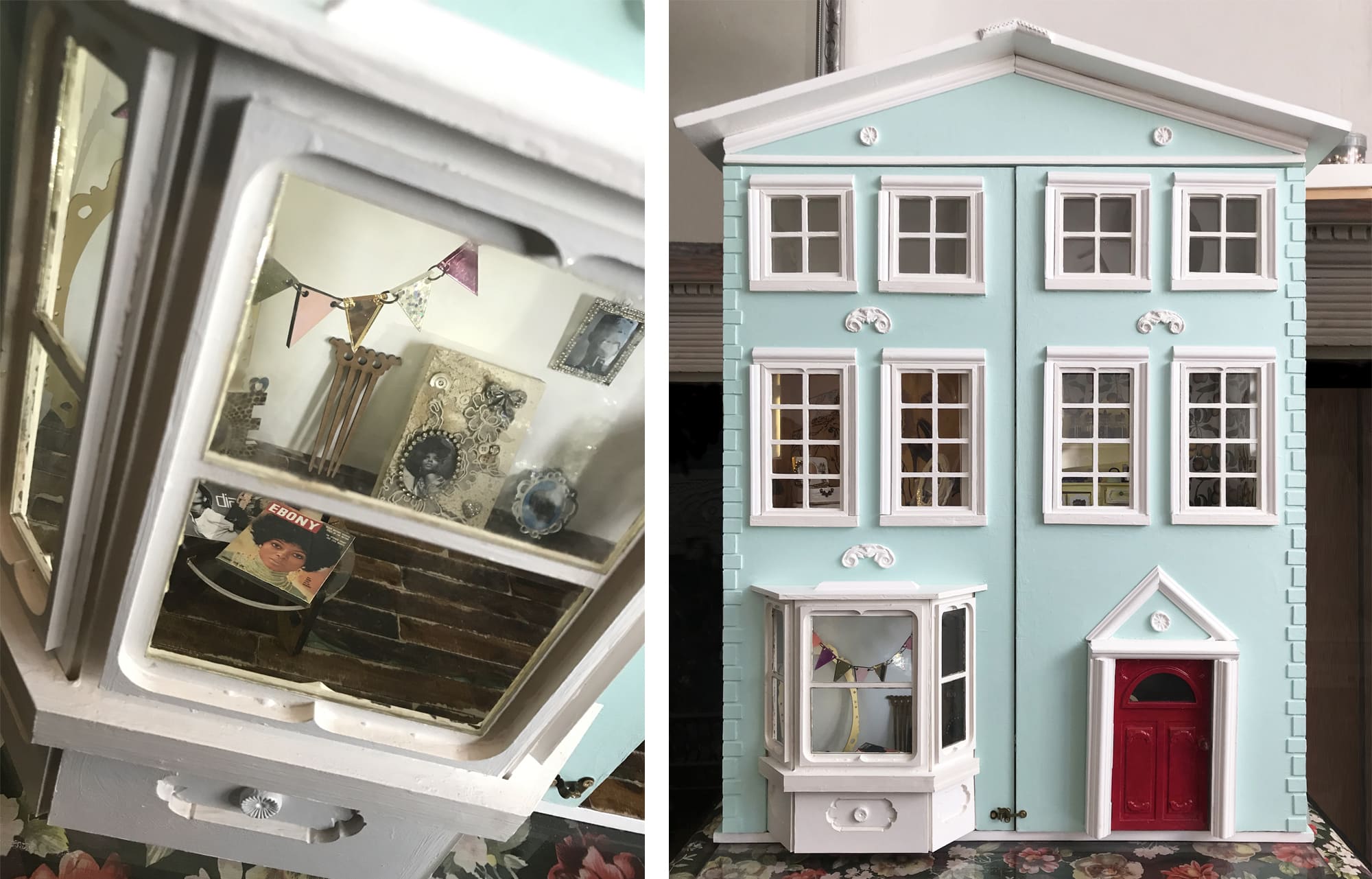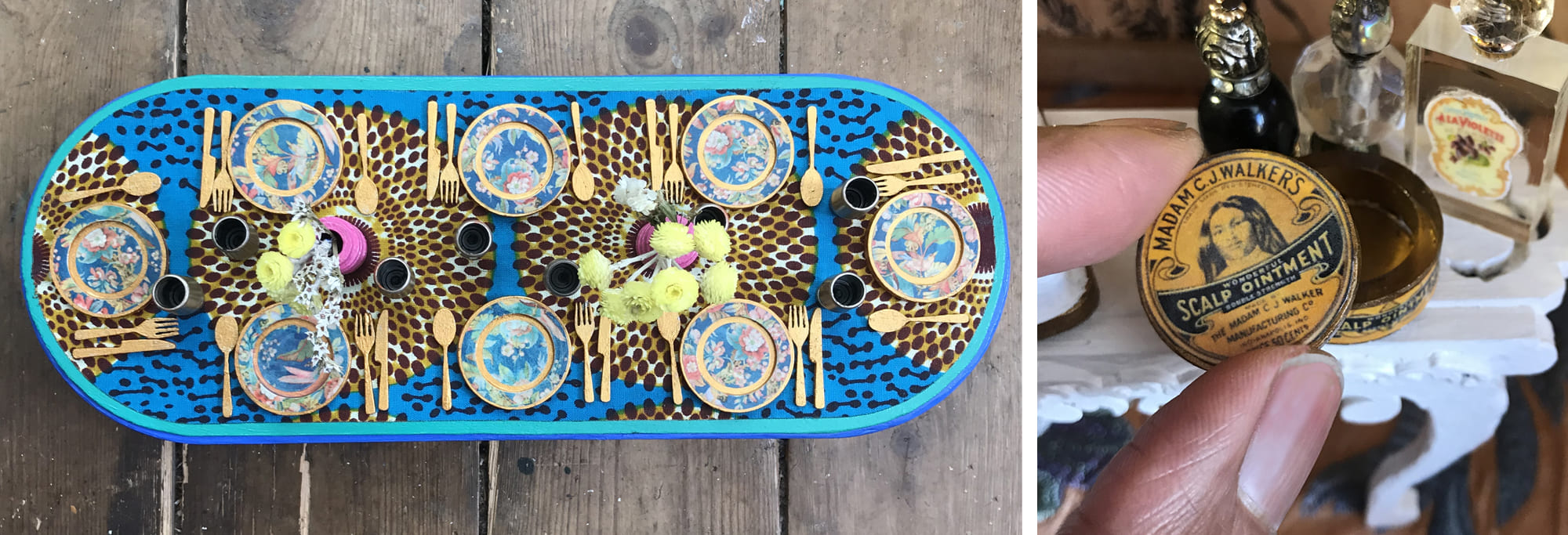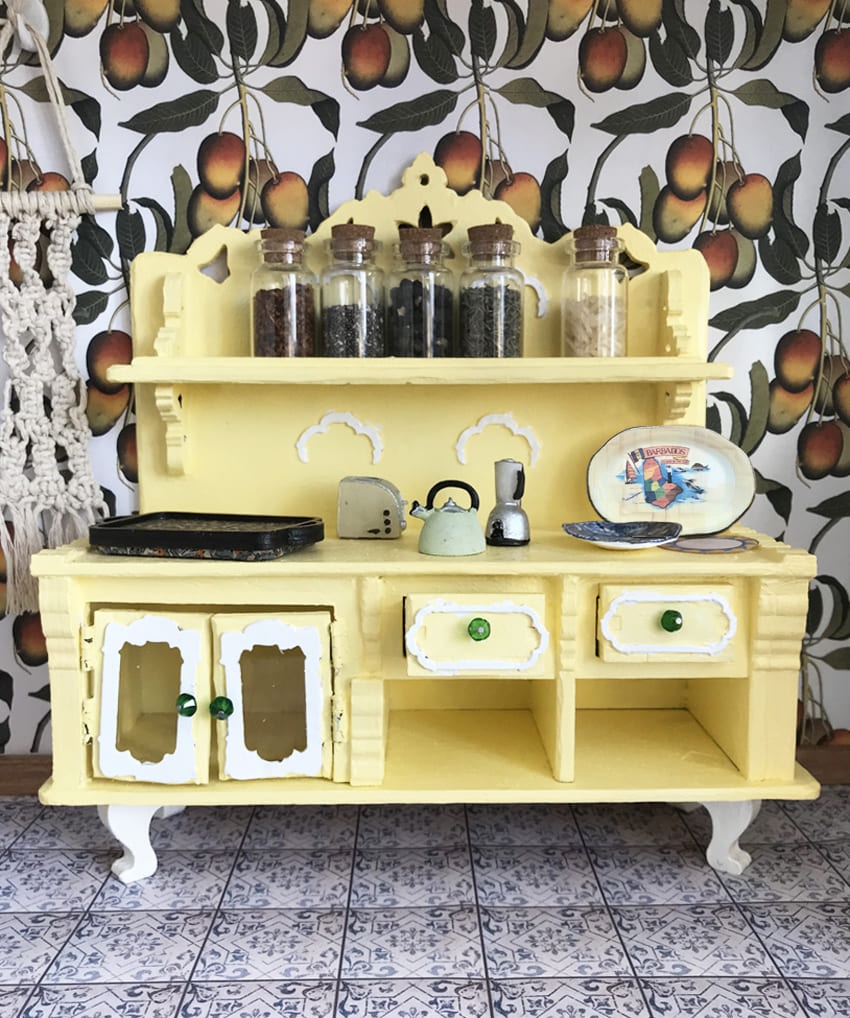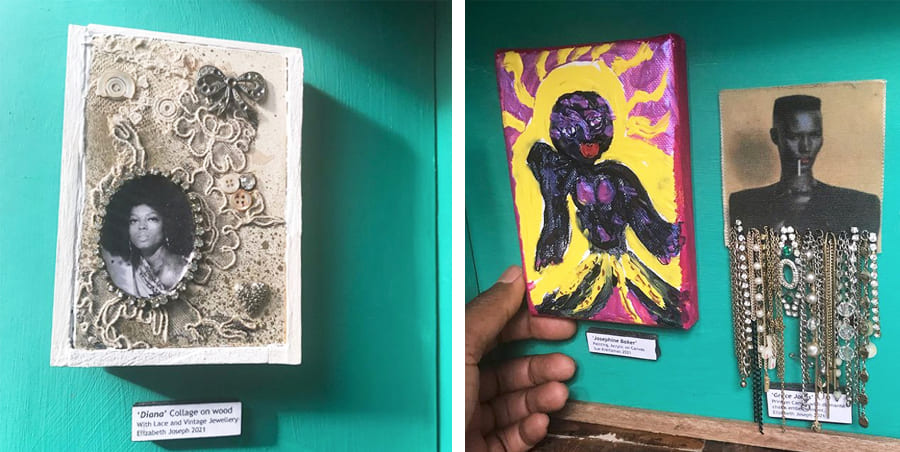With a vast creative background that explores all sectors of the creative industry, Elizabeth Joseph has applied her artistic and resourceful techniques to explore the world in miniature; redefining collectable dollhouses for adults, whilst intrinsically highlighting the beauty of Black culture and personhood. Rooted in the art of storytelling, Elizabeth founded The Black Girl Dollshouse Club; redesigning and reconceptualising the ‘Regency’ period dollhouse aesthetic, and celebrating Black women and identity through cultural representations. I spoke with Elizabeth to discuss the intention and motivation of The Black Girl Dollshouse Club, influences and inspirations, the creative process of working in miniature, the workshops and events she runs, and so much more.
NAHUEL CONTRERASHow did your BA (Hons) Degree in 3-Dimensional design shape your approach to art? What initially drew you to making dollhouses and how did you develop your technique?
 ELIZABETH JOSEPHI worked as a Graphic Designer for 8 years. I’ve also worked as an Interior Design Assistant, and I’m always doing creative courses such as Art History, Botanical Drawing and Fashion Styling. I’m interested in many different creative areas so I find it hard to focus on one idea. I had my first dollshouse aged 7 but that was a “child’s dollshouse”. I’m now into “grown woman dollshousing” that involves spending hours and hours making one piece of furniture, it’s definitely not a child’s play thing! But I’ve always loved collecting and making, whether it’s in miniature or going to a gallery and viewing sculptures or artworks that are over-sized; its the fact that the scale is being played with that draws me in.
ELIZABETH JOSEPHI worked as a Graphic Designer for 8 years. I’ve also worked as an Interior Design Assistant, and I’m always doing creative courses such as Art History, Botanical Drawing and Fashion Styling. I’m interested in many different creative areas so I find it hard to focus on one idea. I had my first dollshouse aged 7 but that was a “child’s dollshouse”. I’m now into “grown woman dollshousing” that involves spending hours and hours making one piece of furniture, it’s definitely not a child’s play thing! But I’ve always loved collecting and making, whether it’s in miniature or going to a gallery and viewing sculptures or artworks that are over-sized; its the fact that the scale is being played with that draws me in. My technique uses the fact that I grew up learning how to re-cycle things and not have the throw it out mentality; meaning that I now like to use wood off-cuts where I can, and I never throw away even the smallest scrap of leftover fabric as it will be perfect to make something from one day. Visiting charity shops is good as there are usually some knick-knacks that can be painted and used in my dollshouse. The Pound Shop is also good for little plant pots and craft materials. Even though these items are tiny, dollshouse accessories are surprisingly expensive and I can’t bring myself to pay money for something that’s one-inch big, the same price as if it were normal sized! Recycling makes things more creative anyway, with a little splurge now and again. NCWho or what influences you? EJI’m influenced, amongst other things, by a mixture of the Georgian/Victorian house exterior aesthetic; I was raised and still live in a Victorian house, art by Black artists, interior design and fashion, and my travels around North Africa. I recently visited Zanele Muholi at Tate Modern. I take in colours, shapes and details, and it will all come out in what I make. I visited the Petrie Museum with my good friend Sue Kreitzman (Google her!) and there were miniature little everyday items like mugs and tiny pots that were made in Ancient Egypt and placed in burial tombs. And influential Black women from Harriet Tubman and Josephine Baker, to Beyoncé and Grace Jones, mainly influence me. NCWhat is your favourite thing about working in miniature? What is the biggest challenge? EJMaking miniature items makes me look at the world differently. Sometimes I’m scrolling through Instagram and my brain sort of ‘miniaturises’ something and I then look at it in dollhouse scale. Also, a small amount of material: wood, resin, fabric, goes a long way because everything is so small. A challenge might be that it’s a niche interest, so it’s slow to get my Tribe together, but we’re getting there…
 NCI’d love to hear more about the creative process of making the dollhouses - from idea development to creation. What materials do you use and where do you source them?
EJThe most famous dollshouse in the UK is Queen Mary’s Dollshouse that is on display at Windsor Castle- (currently closed at the moment). I’m researching the materials that were used in the structure of that dollhouse. Right now I use 12mm MDF and plywood in the structure of my dollhouses, but I want to start using other higher quality hardwoods like Maple or Mahogany. I live in London and I surreptitiously look at all the different style houses, front gardens and exterior walls and gates- yes I’m that boring! I’ve made a traditional Georgian style dollshouse, but I’m imagining the same house with the front covered with ‘African’ (I know that’s not a correct expression) fabric or painting it with Ghanian Adinkra symbols. I buy the wood from my local wood merchants, and craft materials mostly from Amazon or EBay, and the Pound Shop is good for cheap paintbrushes and PVA glue. I use plastic moulds and air-dry clay for details on the front of the house and to make tiny plates for the kitchen. I laser-cut some items like the plates, table and mirror before painting them.
NCThe Black Girl Dollshouse Club is incredibly affirming for Black women. You manifest your vision of redesigning the ‘Regency’ Period dollhouse aesthetic, by reconceptualising the design elements, characteristics and interior design- such as wallpapers, fabrics, decorations and furniture. What was your main motivation for creating the Black Girl Dollshouse Club and what is most rewarding about your work?
EJI’m always designing, drawing or making. For the past few years I’ve been running jewellery workshops for Member’s Clubs but then of course Covid struck- and I wanted to start a new creative project. I was given a dollshouse when I was around 7 years old and I’ve always gone to dollshouse exhibitions, and looked out for miniature objects to buy at car boot sales. So during lockdown I woke up one day, thinking about a new item to make, and I was inspired by a little ‘mini’ dollshouse someone was selling online. I made my own version, based on a typical Caribbean house, and then thought, “why don't I go bigger and make a full sized dollshouse, but bring my own ideas and concepts into it”. The most rewarding side is having a finished miniature item in my hand and placing it in situ. Also, I love doing workshops; but now on making dollshouse items, such as my Miniature Mirror Workshop that I did last week at Allotments Caribbean Restaurant in Barnet.
NCI’d love to hear more about the creative process of making the dollhouses - from idea development to creation. What materials do you use and where do you source them?
EJThe most famous dollshouse in the UK is Queen Mary’s Dollshouse that is on display at Windsor Castle- (currently closed at the moment). I’m researching the materials that were used in the structure of that dollhouse. Right now I use 12mm MDF and plywood in the structure of my dollhouses, but I want to start using other higher quality hardwoods like Maple or Mahogany. I live in London and I surreptitiously look at all the different style houses, front gardens and exterior walls and gates- yes I’m that boring! I’ve made a traditional Georgian style dollshouse, but I’m imagining the same house with the front covered with ‘African’ (I know that’s not a correct expression) fabric or painting it with Ghanian Adinkra symbols. I buy the wood from my local wood merchants, and craft materials mostly from Amazon or EBay, and the Pound Shop is good for cheap paintbrushes and PVA glue. I use plastic moulds and air-dry clay for details on the front of the house and to make tiny plates for the kitchen. I laser-cut some items like the plates, table and mirror before painting them.
NCThe Black Girl Dollshouse Club is incredibly affirming for Black women. You manifest your vision of redesigning the ‘Regency’ Period dollhouse aesthetic, by reconceptualising the design elements, characteristics and interior design- such as wallpapers, fabrics, decorations and furniture. What was your main motivation for creating the Black Girl Dollshouse Club and what is most rewarding about your work?
EJI’m always designing, drawing or making. For the past few years I’ve been running jewellery workshops for Member’s Clubs but then of course Covid struck- and I wanted to start a new creative project. I was given a dollshouse when I was around 7 years old and I’ve always gone to dollshouse exhibitions, and looked out for miniature objects to buy at car boot sales. So during lockdown I woke up one day, thinking about a new item to make, and I was inspired by a little ‘mini’ dollshouse someone was selling online. I made my own version, based on a typical Caribbean house, and then thought, “why don't I go bigger and make a full sized dollshouse, but bring my own ideas and concepts into it”. The most rewarding side is having a finished miniature item in my hand and placing it in situ. Also, I love doing workshops; but now on making dollshouse items, such as my Miniature Mirror Workshop that I did last week at Allotments Caribbean Restaurant in Barnet. It also lends itself well in collaborating with other Black creatives as I can make miniature versions of their work. So far I’ve made a miniature version of an illustrated zine by Korantema Anyimadu, and I’ve made a miniature basket from materials bought from La Basketry.
 NCYou speak on how an intention of BGDHC is to centre Black women’s interests, beliefs and aspirations. Celebrating Black women, identity and personhood, the dollhouse is immersed in cultural representations such as tiny pots of Madam CJ Walker Hair Ointment and afro combs and hot combs in the Josephine Baker illustrated ‘Beauty Room’; the ‘Music Room’ adorned with miniature vinyl records by Donna Summer and Diana Ross, miniature vintage ‘Ebony’ magazines; and artworks of Grace Jones, Serena Williams and Nina Simone in the gallery and event space. Tell me more about the symbolism and significance of visual archiving and cultural referencing in your work?
EJThere is a lot of troubling news that as Black people we have to process every day. I’m trying to create a miniature world filled with positive images, objects and colours that I’d love to live in, even if it’s a dream world in my imagination. It’s like being told about something that you really relate to or want to know more about, but then being able to make a miniature version of it and actually hold it in your hand. It’s not easy being the only Black person in a space, so we’ll club together and enjoy it with one another. It’s just fun to make things.
NCAs mentioned, the dollhouse is embedded in rich and meaningful cultural referencing; including the Caribbean influenced table decorations and homeware, the ‘Mango Tree’ wallpaper and the miniature 'dollhouse in a dollhouse' which you say references a typical Barbadian single storey home, reminiscent of your Great Aunt's home in Barbados. How imperative is introspection to your creative process and how have your own surroundings and lived experiences fed into your work?
EJAs Black people, realising that our creative expression and work is a valuable contribution to the world and not just there to be copied, stolen or parodied is important. I have also been thinking about family heirlooms and being physically apart from Grandparents and other family members can mean that, as children of parents that moved to the UK from abroad, we may not have items handed down to us, due to not being ‘close’ to extended family. My vision is for Black women and men to start creating a family heirloom that is full of a family’s stories and miniature versions of items that no longer exist, and for that dollshouse to be handed down the generations as a family possession with a history.
NCI understand that you have led workshops for companies such as Soho House, The Wing London, The Curtain Hotel and Allotments Restaurant. By building a community of BGDHC members, how has your practice grown and how do you see it continuing to develop?
EJI only started The Black Girl Dollshouses Club Instagram a couple of months ago so my audience is still small at the moment, but I’m glad that I’ll have a ‘niche’ following of people that are really interested in dollshouses. I have a newsletter with a growing list of subscribers, and as things start opening up again, I’ll put on more workshops. I’m also planning a monthly subscription where I can make a custom ‘Heirloom Dollshouse’ for clients that is built up over a year with me guiding them through the decoration and furnishings, and buying things online, as well as some personalised handmade items.
NCYour dollhouses are rooted in the art of storytelling and also fantasy, exploring representation and linking reality with your imagination. What is your hope for the field of dollhouses?
NCYou speak on how an intention of BGDHC is to centre Black women’s interests, beliefs and aspirations. Celebrating Black women, identity and personhood, the dollhouse is immersed in cultural representations such as tiny pots of Madam CJ Walker Hair Ointment and afro combs and hot combs in the Josephine Baker illustrated ‘Beauty Room’; the ‘Music Room’ adorned with miniature vinyl records by Donna Summer and Diana Ross, miniature vintage ‘Ebony’ magazines; and artworks of Grace Jones, Serena Williams and Nina Simone in the gallery and event space. Tell me more about the symbolism and significance of visual archiving and cultural referencing in your work?
EJThere is a lot of troubling news that as Black people we have to process every day. I’m trying to create a miniature world filled with positive images, objects and colours that I’d love to live in, even if it’s a dream world in my imagination. It’s like being told about something that you really relate to or want to know more about, but then being able to make a miniature version of it and actually hold it in your hand. It’s not easy being the only Black person in a space, so we’ll club together and enjoy it with one another. It’s just fun to make things.
NCAs mentioned, the dollhouse is embedded in rich and meaningful cultural referencing; including the Caribbean influenced table decorations and homeware, the ‘Mango Tree’ wallpaper and the miniature 'dollhouse in a dollhouse' which you say references a typical Barbadian single storey home, reminiscent of your Great Aunt's home in Barbados. How imperative is introspection to your creative process and how have your own surroundings and lived experiences fed into your work?
EJAs Black people, realising that our creative expression and work is a valuable contribution to the world and not just there to be copied, stolen or parodied is important. I have also been thinking about family heirlooms and being physically apart from Grandparents and other family members can mean that, as children of parents that moved to the UK from abroad, we may not have items handed down to us, due to not being ‘close’ to extended family. My vision is for Black women and men to start creating a family heirloom that is full of a family’s stories and miniature versions of items that no longer exist, and for that dollshouse to be handed down the generations as a family possession with a history.
NCI understand that you have led workshops for companies such as Soho House, The Wing London, The Curtain Hotel and Allotments Restaurant. By building a community of BGDHC members, how has your practice grown and how do you see it continuing to develop?
EJI only started The Black Girl Dollshouses Club Instagram a couple of months ago so my audience is still small at the moment, but I’m glad that I’ll have a ‘niche’ following of people that are really interested in dollshouses. I have a newsletter with a growing list of subscribers, and as things start opening up again, I’ll put on more workshops. I’m also planning a monthly subscription where I can make a custom ‘Heirloom Dollshouse’ for clients that is built up over a year with me guiding them through the decoration and furnishings, and buying things online, as well as some personalised handmade items.
NCYour dollhouses are rooted in the art of storytelling and also fantasy, exploring representation and linking reality with your imagination. What is your hope for the field of dollhouses?
 EJRight now adult dollshouse appreciation has an older, middle-class image, and I want to create a space where we can feel at home and not tip-toe around the edges of a world that doesn’t reflect our tastes and histories. I still love looking at people’s ‘Regency’ style dollhouses, and the reason they are so loved is all that hand wood-turning on a lathe and carefully carved details that are captivating in miniature form. But the anonymous framed portraits of random Victorian landowners? I don’t really relate to them that much. People that collect things and want truly unique items in their home are usually creative and passionate and don’t just focus on the monetary value of things. Idealistic I know; I’m a dreamer.
EJRight now adult dollshouse appreciation has an older, middle-class image, and I want to create a space where we can feel at home and not tip-toe around the edges of a world that doesn’t reflect our tastes and histories. I still love looking at people’s ‘Regency’ style dollhouses, and the reason they are so loved is all that hand wood-turning on a lathe and carefully carved details that are captivating in miniature form. But the anonymous framed portraits of random Victorian landowners? I don’t really relate to them that much. People that collect things and want truly unique items in their home are usually creative and passionate and don’t just focus on the monetary value of things. Idealistic I know; I’m a dreamer. Just as knitting was 10 years ago, it is now a fashionable trend. If you haven’t picked up a pair of knitting needles and given it a go, where have you been? I think dollshouse appreciation and collecting will be the next big trend. You don’t have to have a full sized dollshouse in your home but can have just a “room box” or even just collect miniature items and line them up on your mantelpiece. NCPersonally or professionally, what are you currently working on? EJI have a lot of ideas; I haven’t got enough time to work on everything. But I’m planning the ground floor of my dollshouse to be an Art Gallery, with a miniature art exhibition which I’ll display on my Instagram and website, during the same time that the Summer Exhibition at the RA will start, this September, which is coordinated by artist Yinka Shonibare. My exhibition will feature my own artworks and I’m also going to ask Black UK artists if they’d like to donate a miniature work or art/sculpture/zine to display. Everything will be on sale and the proceeds will go to a children’s charity.
I have all sorts of crazy ideas pop into my head from time to time… I want to produce a TV series where each participant is given the same materials and has to make a dollshouse item from them. ‘The Miniature Makeoff’ (you saw it here first).
Thank you for asking me to be part of the Black London Creatives website.